Can You Have a Sloth as a Pet? Do They Make Good Pets?
Key Points
- Sloths are legal to own as a pet in 24 states, with some states requiring special exotic animal permits to show proof of ownership.
- Owning a slot requires a lot of maintenance because they suffer from nutritional deficiencies and health problems from their environment not resembling their natural habitat.
- Sloths are extremely expensive to obtain, costing between $6,000 and $10,000 for a captive-bred infant.
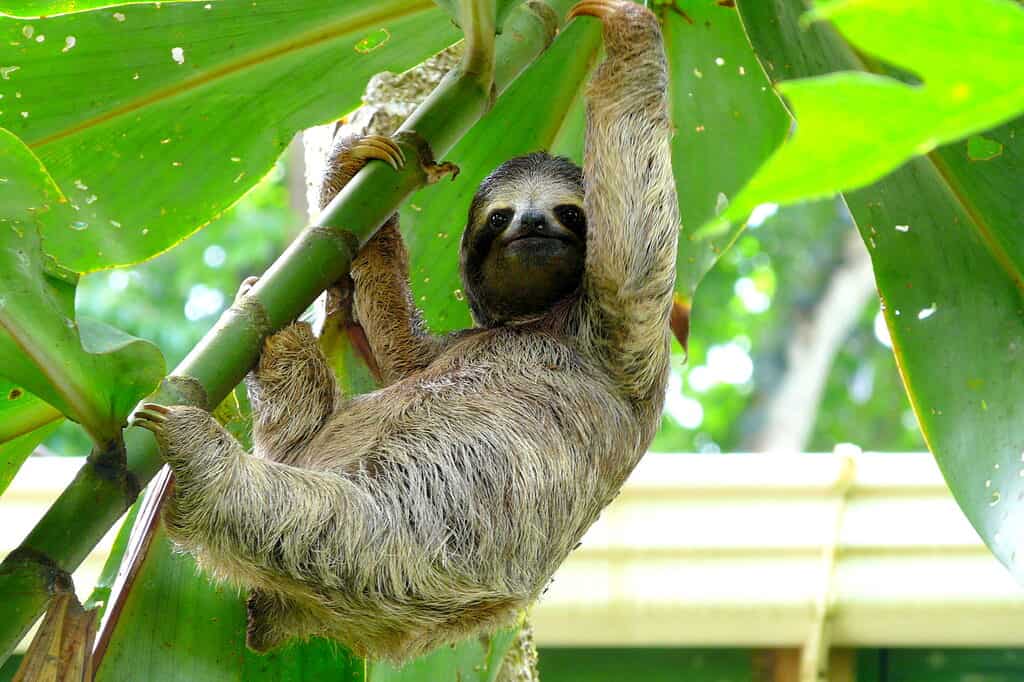
©Nacho Such/Shutterstock.com
There is a special allure to owning an exotic animal. The charm of having guests over to show off something new and unique. It is a thrill imagining having a somewhat wild animal living at home.
Common exotic animals are skunks, snakes, amphibians, and birds. They are somewhat or moderately domesticated where they know how to interact with humans thanks to years of integration with society.
Sloths are still up for debate as to whether they make good pets or not. They move exceptionally slowly so there is little risk of them getting away, they seem cute and happy while in zoos. Their only leaf diet seems simple enough to provide for them; so why is there so much chatter about them being difficult pets?
What Sloths Can Be Owned as Pets?
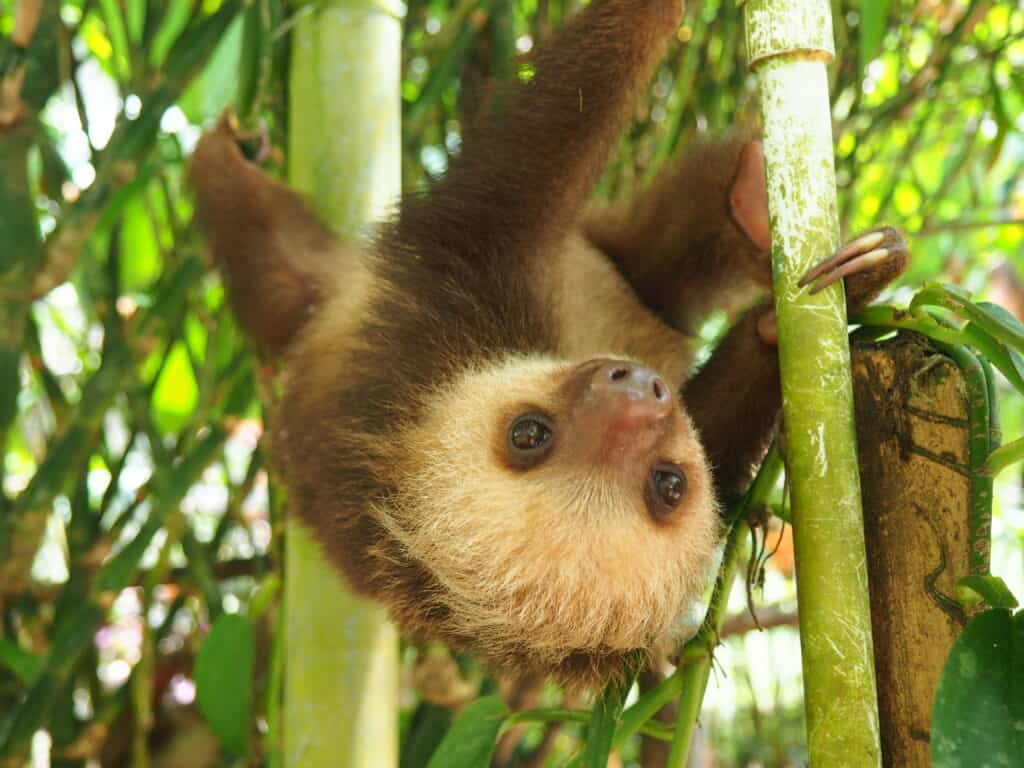
©Kristel Segeren/Shutterstock.com
There are two types of sloth in the world and six different sloth species. The only sloth someone can own as a pet are two-toed sloths.
Two-toed sloths live approximately 20 years in the wild but can live 30-40 years in captivity. A two-toed sloth named Paula is the oldest in captivity, living for 50 years in the Halle Zoo in Saxony-Anhalt, Germany in 1971.
Sloths have a strict diet of leaves, twigs, and assorted buds native to Central and South America trees. They are nocturnal animals, sleeping 20 hours a day to conserve energy to forage for food at night.
Why Do Sloths Move So Slow?
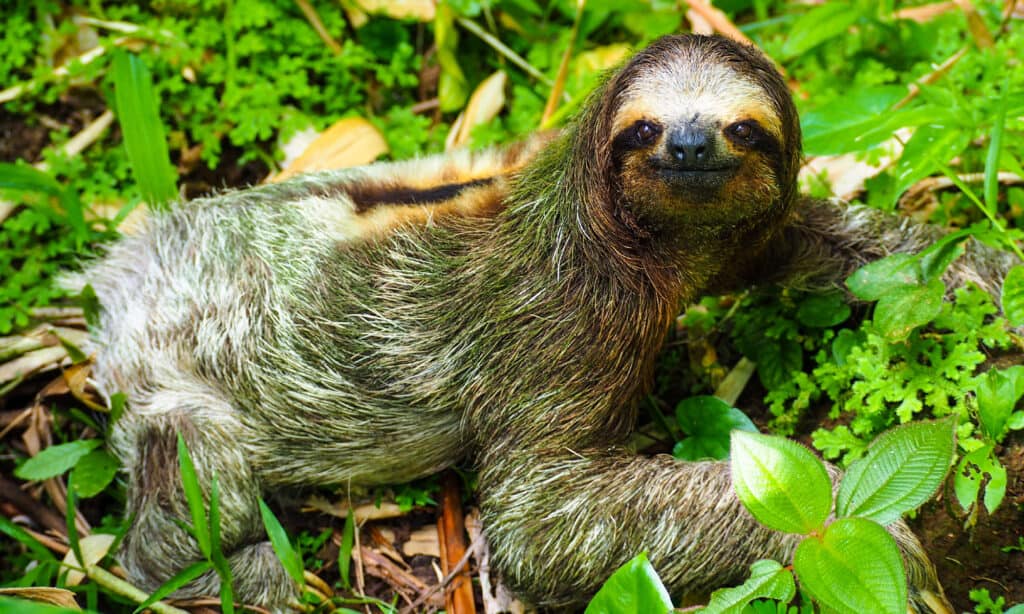
©Kristel Segeren/Shutterstock.com
It is imperative for potential sloth owners to understand why these animals move so slowly because it will affect how to care for them properly.
Sloths move slowly because they have incredibly slow metabolisms. Their diet consists of mostly plant vegetation, which can be difficult to digest. In fact, sloths digest their food over weeks instead of most animals over a few hours.
Sloths are physically incapable of moving quickly because their bodies are designed to conserve energy. They sleep for the majority of the day and feed on a diet of low calories and overall poor nutrition that they cannot more than a snail’s pace.
In the wild, sloths use camouflage to hide from predators because they cannot defend themselves or flee.
Their slow movement is the reason why sloths are allowed in so many states. There is little risk of them escaping and causing damage to wildlife.
What States Allow Sloths as Pets?
According to the World Population Review’s latest update in February 2023, 35 states allow homeowners to own sloths as pets. There are nine states prohibiting sloth ownership, with the rest being undetermined.
States Where Sloth Ownership is Legal
| Alabama | Arkansas | Delaware | Florida | Hawaii | Idaho |
| Indiana | Iowa | Kansas | Kentucky | Louisiana | Maryland |
| Massachusetts | Michigan | Minnesota | Mississippi | Missouri | Montana |
| Nevada | New Jersey | New Mexico | New York | North Carolina | North Dakota |
| Ohio | Oklahoma | Oregon | Pennsylvania | South Carolina | South Dakota |
| Texas | Washington | West Virginia | Wisconsin | Wyoming |
States Where Sloth Ownership is Illegal
| Arizona | California | Colorado |
| Georgia | Maine | New Hampshire |
| Rhode Island | Utah | Vermont |
Any state not on this list is undecided about owning sloths as pets. Potential buyers should check with their local government on what permits are required to own a sloth.
Requirements for Sloth Ownership
Sloth owners will have to research permits, state laws, and a general understanding of how two-toed sloths act and behave.
They may seem easy to care for on the outside, but these animals are very picky about their surroundings which makes them incompatible with domesticated living.
Simulated Habitat

©Nick Wiltgen/iStock via Getty Images
Sloths are native to Central and South America, places famous for tropical jungles. Two-toed sloths evolved to thrive in rainforests and tropical forest conditions. Homeowners need to simulate that environment in their homes if they want to keep their sloth happy and healthy.
Sloths require tall trees with sturdy branches to support their 14-pound bodies. They do not like being on the ground floor, preferring to stay in trees.
Additionally, sloths need a constant temperature of high humidity and heat to keep them healthy. Sloths cannot handle air conditioning and dry heat. Similar to snakes, sloths will get sick if their environment does not simulate their natural habitat with appropriate heating and humidity.
Specific Diet
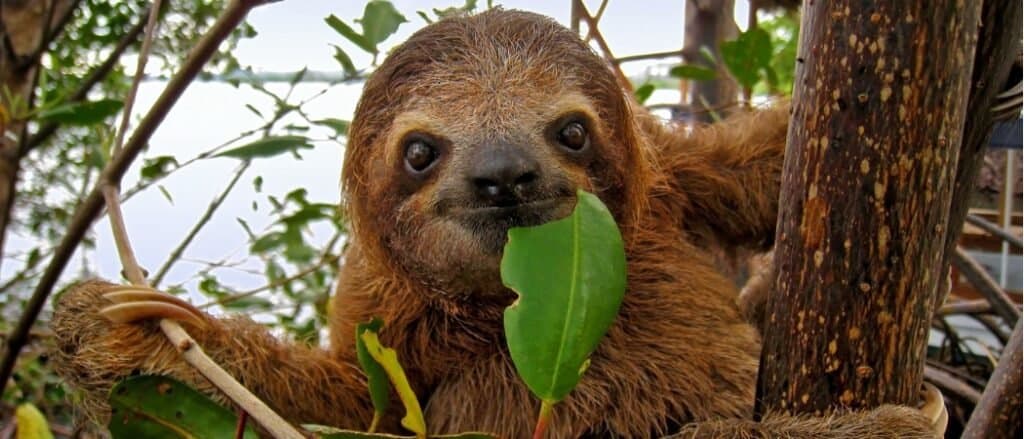
©Damsea/Shutterstock.com
Two-toed sloths eat an unbalanced diet of leafy greens, with some occasional insects, bird eggs, and lizards if they are around. Primarily, they eat leaves, figs, twigs, and buds specifically from trees in Central and South America.
Understandably, finding leaves from tropical jungles is difficult in North America. Sloths cannot eat any leaves from outside because their bodies cannot process them well. Trees and leaves in North America are different from trees in Central and South America, so a sloth cannot survive in the wild if released.
Sloth owners will have to special order leaves from out of state or speak with a reputable sloth breeder or exotic animal veterinarian to create a balanced diet.
Tips on Caring for Pet Sloth
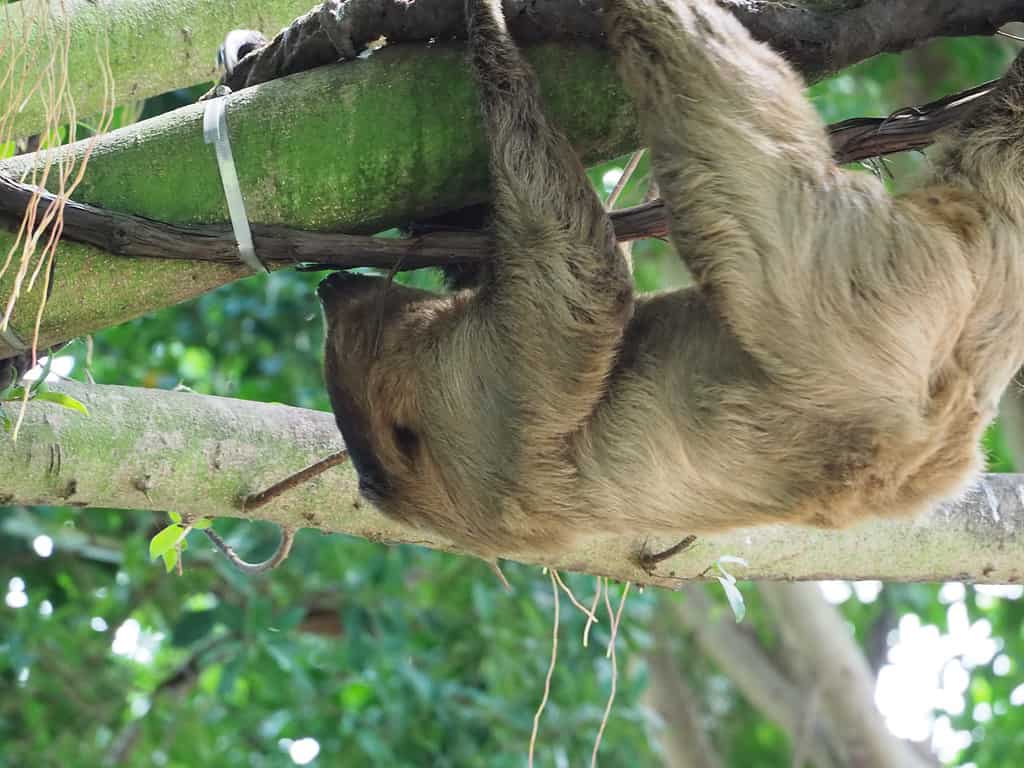
©Pamela Carpenter/iStock via Getty Images
Thankfully, sloths do not need extra attention or physical maintenance like other animals because of their slow metabolisms. The charm of owning a sloth is knowing they are slow, and they do not need much effort.
Follow these important tips to care for a pet sloth:
Not Domesticated Animals
It is crucial to remember that sloths are not domesticated animals. They have not been working with humans for thousands of years, building a mutual relationship of affection and trust. Sloths may still see humans as large predators or another large animal that moves faster than them, but not interested in eating them.
Owners must be patient to establish trust with their sloths, which can take several years.
Seek Professional Guidance
Speak with local zoos, exotic animal veterinarians, or reputable sloth breeders regarding diet, habitat construction, and engagement. Finding a veterinarian will be difficult since there are separate certifications for Doctors to work with exotic animals. Sloths are uncommon pets so regular veterinarians may not know how to care for them. Zoos and breeders will have more information and recommendations available.
Limited Physical Engagement
The main gimmick of sloths is that they are slow. Owners do not need to take them for walks, play games, take them out, or do anything with them since they are incapable of physical engagement the way a dog or cat would.
Owners should limit hugging or cuddling with their sloths since they do know now what those actions mean. Sloths are solitary animals and do not interact with other animals outside of mating season.
Minimal Clean-Up and Grooming
Sloths do not need traditional grooming like bathing and brushing. Being mostly wild animals, they do not understand those actions and may become frightened by them. Sloths move so slowly that they develop microorganisms on their body to help eat bacteria and fungi that grow on their skin. Removing those microorganisms may cause more harm to their bodies and reduce their ability to handle the foreign environment.
Sloths have minimal clean-up because they digest food over weeks or months. On average, a sloth will urinate and defecate once or twice a week.
Also, do not trim sloth nails. Sloths use their long nails to hold onto tree branches and grab food. They will become disoriented and struggle to perform normal tasks if their nails are cut.
Health Problems with Pet Sloths
Owning sloths sounds exciting from the outside, but owners must be ready in case their sloth gets sick and needs medical attention. Due to their strict diets and environmental requirements, pet sloths are prone to several illnesses which may become fatal.
- Nutritional Deficiencies: A nutritional deficiency is when an animal is not getting the proper nutrients to sustain their bodies and becomes sick. Without a proper diet, sloths will appear weak with low energy, while their organs shut down from malnutrition.
- Digestive Issues: Aside from improper nutrients, giving the wrong foods may lead to other complications like gastrointestinal problems. Symptoms like vomiting or diarrhea indicate the sloth’s diet is not settling in their stomachs well.
- Respiratory Issues: Pet sloths may suffer from breathing complications because of environmental attributes in the air. Sloth owners must provide their sloths with a room with high temperatures with plenty of humidity to simulate their natural environment so they can breathe effectively.
Do Sloths Make Good Pets?
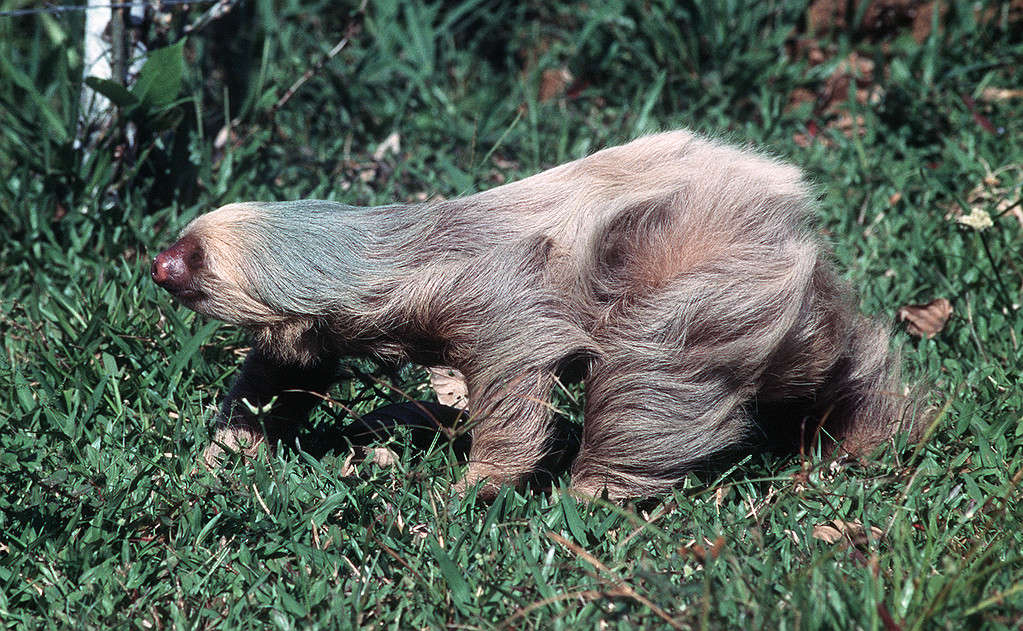
©Steffen Foerster/iStock via Getty Images
Before deciding, let’s weigh the factors of owning a sloth.
| Sloth Ownership Pros | Sloth Ownership Cons |
|---|---|
| Bragging points for owning an exotic animal | Costs $6,000-$10,000 to obtain |
| Minimal physical interaction | Very few exotic animal veterinarians |
| Brings joy to the owner | Expensive medical bills (exotic animals are more expensive for medical visits) |
| Difficult to obtain proper nutrients in stores | |
| Do not like being touched or hugged | |
| Get sick easily from malnutrition and improper habitat settings |
The final verdict, sloths do not seem to make the best pets. They have a high risk of becoming sick, few options for medical care, heightened expenses for medical care, and high sensitivity to the environment make them difficult animals to care for.
If someone is dead set on owning a sloth, then it will be an uphill battle caring for them. Otherwise, it might be just as engaging to see a sloth at a zoo or register for an exotic animal encounter where the family can meet a sloth up close.









